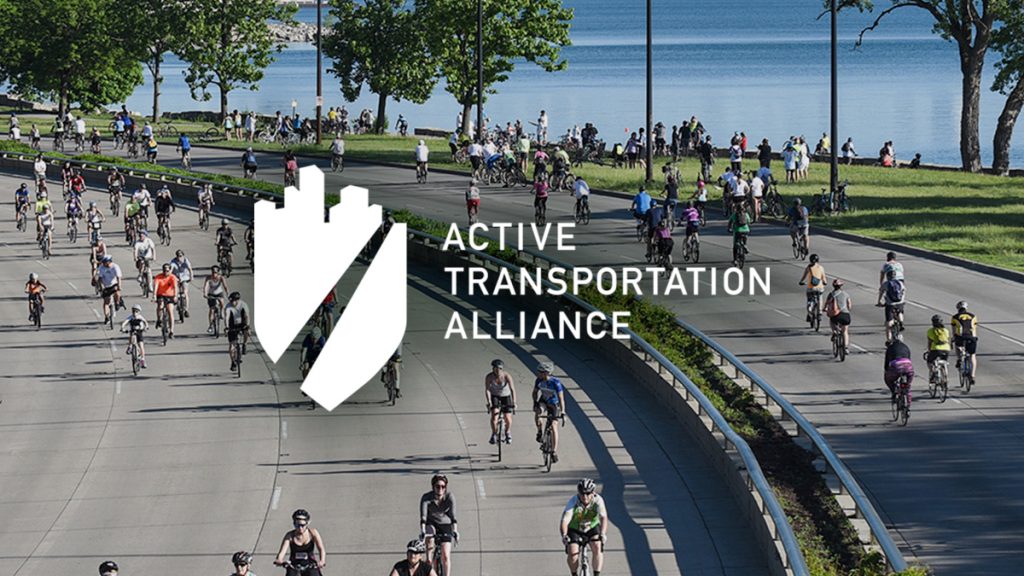Back in 2010-11 when Active Trans asked Chicago mayoral candidates to support a 100-mile network of protected bike lanes by 2015, many scoffed. That may fly in Europe, we were told, but this is Chicago. Cars are king and cyclists are lucky to get a white stripe between themselves and cars.
But Mayor Rahm Emanuel loved the idea and so did his Chicago Department of Transportation Commissioner, Gabe Klein. Within 30 days of Emanuel’s inauguration, the city’s first protected bike lane was installed on Kinzie St.
Many more projects have followed, and Chicago is leading the nation on advanced bike infrastructure:
- Chicago has roughly 50 miles of protected and buffered bike lanes currently and expects to add another 40 miles this year.
- Kinzie St. and the southern section of Milwaukee Ave. are among the busiest bike routes in the nation.
- The Dearborn St. two-way protected bike lane in the Loop was recently named the nation’s best.
- The state of Illinois recently agreed to allow protected bike lanes on some state-owned routes in Chicago, including a stretch of Clybourn Ave.
According to data collected from the Green Lanes Project, since 2011 Chicago has built nearly twice as many miles of barrier-protected bike lanes than any American city including New York, Portland and San Francisco.
But 100 miles by 2015? Well, that’s proven to be a very ambitious goal the city won’t meet. The city is counting protected and buffered bike lanes towards meeting a 100 mile goal for “advanced” bike lanes, which will be a huge accomplishment and way ahead of other cities.
We love buffered lanes, too, but remain committed to at least 100 miles of protected lanes as part of a comprehensive network.
Support from the mayor and aldermen has been crucial for these projects and is directly linked to strong grassroots support across the city. Through our on-the-ground mobilizing efforts, 12,000 Active Trans members and supporters signed petitions, turned out to public meetings, and made their voices heard in local media.
Of course, those of us who ride bikes know that coasting on your momentum will only take you so far. So with one year to go before the next round of municipal elections, now is a good time to take stock of where we are and where we want to go:
Design and maintenance of barrier protected lanes.
These lanes are the safest and most popular design for average Chicagoans who are not yet “confident” cyclists. It’s our favorite design on streets where it works. Sweeping, snow removal and standing water are areas for improvement (while keeping in mind that this past winter has been one of worst recorded winters for snow and ice accumulation).
“Hardscaping” on protected lanes.
In order to make quick progress and demonstrate “proof of concept,” all on a shoestring budget, Chicago has used basic plastic bollards, parked cars and white lines for its protected bike lanes. The next generation of lanes can use permanent and more attractive ways to separate traffic wherever possible, like curbs, landscaped medians or raised bike lanes.
Buffered vs. protected bike lanes.
More than half of the city’s first 100 miles of advanced bike lanes are currently expected to be buffered bike lanes. With enough community support, some of these can be built as barrier-protected instead. In addition, buffered lanes can be enhanced with “bots dots,” reflectors or some other raised delineator in the left-side buffer zone that still allows cars and bikes to pass.
Closing gaps to create a connected network of low-stress routes.
Bike lanes are only useful if they connect people to where they want to go. Luckily, Chicago’s Streets for Cycling 2020 plan lays out a robust 645 mile network generated directly from community input. Filling in gaps and key links in our network will be essential to making biking an easy way for people to complete everyday trips.
Adding more Neighborhood Greenways on less-busy side streets.
In 2013, Chicago saw its first Neighborhood Greenway installed on Berteau Ave. with a second slated for Leland Ave. in Uptown this year. Neighborhood Greenways take advantage of Chicago’s strong street grid system by optimizing low-traffic residential side streets for people riding bikes. Expanding these types of facilities will help create a more comfortable riding experience and make cycling a more attractive alternative for more people.
As we have already witnessed, these improvements will be challenged by some local elected officials and community members who are unwilling to make some of the tradeoffs required, like rearranging street parking or reconfiguring lanes on a street.
It’s our job to respond to this challenge. Now is not the time to back down. We must redouble our efforts and continue to find new and creative ways to build support among our neighbors and leaders. And we can’t do it alone. Join the movement to create an even better bike network in Chicago by signing up for updates and alerts.

